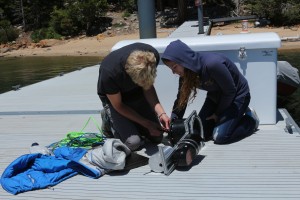 Our group was awarded a one year grant to aimed to develop robust 3D imaging techniques to study underwater archaeological sites. The grant, “Mapping and Visualizing Complex, Large-Scale Underwater Archaeological Sites and Artifacts” will extend the work done by Perry Naughton, Antonella Wilby and other Engineers for Exploration group members to create a multi-camera underwater system. The key contribution is to develop accurate localization in order to supplement the camera location information during the construction of the 3D models. Teledyne has generously loaned us an Explorer Doppler Velocity Log which we have coupled with an IMU, optical location techniques (e.g., optical flow), and acoustic ranging via buoys in order to get an accurate location lock for each picture taken. Press references [Qualcomm Institute, UCSD CSE]
Our group was awarded a one year grant to aimed to develop robust 3D imaging techniques to study underwater archaeological sites. The grant, “Mapping and Visualizing Complex, Large-Scale Underwater Archaeological Sites and Artifacts” will extend the work done by Perry Naughton, Antonella Wilby and other Engineers for Exploration group members to create a multi-camera underwater system. The key contribution is to develop accurate localization in order to supplement the camera location information during the construction of the 3D models. Teledyne has generously loaned us an Explorer Doppler Velocity Log which we have coupled with an IMU, optical location techniques (e.g., optical flow), and acoustic ranging via buoys in order to get an accurate location lock for each picture taken. Press references [Qualcomm Institute, UCSD CSE]
Author Archives: Ryan
New(ish) Post-Doc: Vinnie Wei Hu
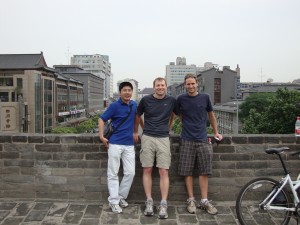 Vinnie Wei Hu recently returned back to our research group from Xi’an, China. Vinnie is no stranger to UCSD. He spent two years here as a visiting graduate student starting in 2009. During his visit, he worked with Ryan, Dr. Jason Oberg, and Dr. Ali Irturk on hardware security, specifically developing the theory behind gate level information flow tracking (GLIFT). After going back to Xi’an to finish his Ph.D, he is now starting his second stint in the Kastner Research Group to extend his research in hardware security. He plans to work on developing GLIFT for secure hardware design & verification and for enforcing embedded system security in order to secure the internet-of-things as well as cyber physical systems. Furthermore, he is looking into some research related to timing and power attacks on hardware involved in secure applications.
Vinnie Wei Hu recently returned back to our research group from Xi’an, China. Vinnie is no stranger to UCSD. He spent two years here as a visiting graduate student starting in 2009. During his visit, he worked with Ryan, Dr. Jason Oberg, and Dr. Ali Irturk on hardware security, specifically developing the theory behind gate level information flow tracking (GLIFT). After going back to Xi’an to finish his Ph.D, he is now starting his second stint in the Kastner Research Group to extend his research in hardware security. He plans to work on developing GLIFT for secure hardware design & verification and for enforcing embedded system security in order to secure the internet-of-things as well as cyber physical systems. Furthermore, he is looking into some research related to timing and power attacks on hardware involved in secure applications.
Ryan and Jason were hosted by Vinnie in China a couple of years ago and visited Museum of Terra-cotta Horses and Soldiers and rode around the 14 kilometer city wall built over 600 years ago (the picture is taken on that city wall). Welcome back Vinnie Wei Hu to the land of eternal sunshine!
Hardware Security Lattice Paper Accepted to ACM TODAES
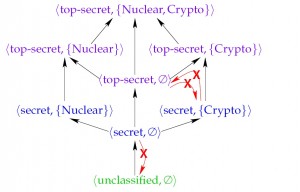 Our work on formalizing gate level information flow tracking (GLIFT) to handle multiple labels was accepted to the ACM Transactions on Design Automation of Electronic Systems (TODAES). The article titled “Gate Level Information Flow Tracking for Security Lattices” extends the ability to track only two labels (e.g., trusted/untrusted) to larger number of comparable labels. For example, we could mark hardware cores as “verified built in-house”, “tested built in-house”, “verified external source”, “tested external source”, and “untested external”. In each case, there is a varying level of trust. With the ability to track these multiple labels, we can then understand how the various hardware cores affect each other. The lead author was our new post-doc Vinnie Wei Hu with co-authors Dejun Mu, Jason Oberg, Baolei Mao, Mohit Tiwari, Timothy Sherwood, and Ryan Kastner.
Our work on formalizing gate level information flow tracking (GLIFT) to handle multiple labels was accepted to the ACM Transactions on Design Automation of Electronic Systems (TODAES). The article titled “Gate Level Information Flow Tracking for Security Lattices” extends the ability to track only two labels (e.g., trusted/untrusted) to larger number of comparable labels. For example, we could mark hardware cores as “verified built in-house”, “tested built in-house”, “verified external source”, “tested external source”, and “untested external”. In each case, there is a varying level of trust. With the ability to track these multiple labels, we can then understand how the various hardware cores affect each other. The lead author was our new post-doc Vinnie Wei Hu with co-authors Dejun Mu, Jason Oberg, Baolei Mao, Mohit Tiwari, Timothy Sherwood, and Ryan Kastner.
Embedded System Design Class Projects
CSE 145 and CSE 237D combine the talents of undergraduate and graduate students to develop quarter long projects on a variety of topics in embedded systems. This year saw the development of a number of great projects. Many were proposed by Ryan and members of our research group. A number of them came directly from the students. All of the students put in countless hours to develop these projects, which were highlighted in news releases from the Jacobs School of Engineering and a two part series at Calit2 (Part 1, Part 2). The classes will be offered again in Spring 2015. Start thinking of some good ideas for next year!
combine the talents of undergraduate and graduate students to develop quarter long projects on a variety of topics in embedded systems. This year saw the development of a number of great projects. Many were proposed by Ryan and members of our research group. A number of them came directly from the students. All of the students put in countless hours to develop these projects, which were highlighted in news releases from the Jacobs School of Engineering and a two part series at Calit2 (Part 1, Part 2). The classes will be offered again in Spring 2015. Start thinking of some good ideas for next year!
Hardware Security Technology Highlighted in Various News Outlets
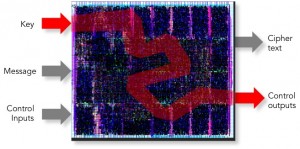 The hardware security techniques developed in our research group, and being commercialized by Tortuga Logic, recently received a significant amount of news coverage. This all started with a story from the Jacobs School of Engineering that got picked up by a number of different venues including ACM TechNews, Calit2, R&D Magazine, Science Codex, Counsel and Heal, Phys.org, Science Daily, RF Globalnet, Product Design and Development, Red Orbit, and probably several others that I have missed. The International Business Times also interviewed Ryan and put out a rather lengthy story.
The hardware security techniques developed in our research group, and being commercialized by Tortuga Logic, recently received a significant amount of news coverage. This all started with a story from the Jacobs School of Engineering that got picked up by a number of different venues including ACM TechNews, Calit2, R&D Magazine, Science Codex, Counsel and Heal, Phys.org, Science Daily, RF Globalnet, Product Design and Development, Red Orbit, and probably several others that I have missed. The International Business Times also interviewed Ryan and put out a rather lengthy story.
Three papers accepted to FPL 2014
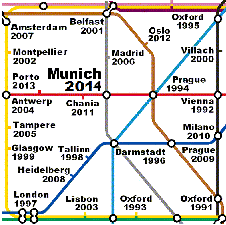 Our group continues its success at FPL following up last years three papers and best paper award with three papers in this upcoming FPL to be held in Munich, Germany in September. Pingfan was the lead author on the paper “Hardware Accelerated Novel Optical De Novo Assembly for Large-Scale Genomes” which develops a hardware accelerated solution for genome matching. This paper was done in collaboration with our friends at BioNano Genomics. The second accepted paper was “Improving FPGA Accelerated Tracking with Multiple Online Trained Classifiers” with Matt as the lead author. This paper utilizes the performance of FPGAs to create a robust tracker by training the features in an online manner. Dajung was the lead author on the final paper, “High Throughput Channel Tracking for JTRS Wireless Channel Emulation”, which developed a channel tracker which is an integral part of the wireless channel emulator project with Toyon Research Group. Congrats and beifall to all the authors!
Our group continues its success at FPL following up last years three papers and best paper award with three papers in this upcoming FPL to be held in Munich, Germany in September. Pingfan was the lead author on the paper “Hardware Accelerated Novel Optical De Novo Assembly for Large-Scale Genomes” which develops a hardware accelerated solution for genome matching. This paper was done in collaboration with our friends at BioNano Genomics. The second accepted paper was “Improving FPGA Accelerated Tracking with Multiple Online Trained Classifiers” with Matt as the lead author. This paper utilizes the performance of FPGAs to create a robust tracker by training the features in an online manner. Dajung was the lead author on the final paper, “High Throughput Channel Tracking for JTRS Wireless Channel Emulation”, which developed a channel tracker which is an integral part of the wireless channel emulator project with Toyon Research Group. Congrats and beifall to all the authors!
Two more add “Dr” to their names
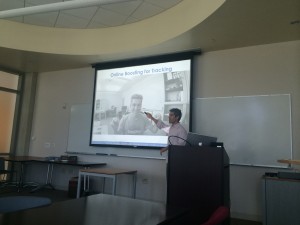
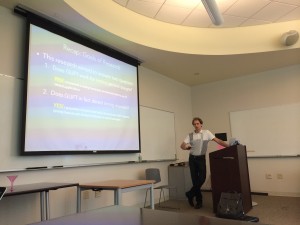 Matt and Jason successfully defended their theses bringing the total to three people who have graduated with PhDs from the Kastner Group this year. Matt’s research focused on developing a Smart Frame Grabber framework to ease the development of building computer vision applications using heterogeneous systems. Jason’s research on hardware security developed the first method for determining the existence of timing channels in hardware.
Matt and Jason successfully defended their theses bringing the total to three people who have graduated with PhDs from the Kastner Group this year. Matt’s research focused on developing a Smart Frame Grabber framework to ease the development of building computer vision applications using heterogeneous systems. Jason’s research on hardware security developed the first method for determining the existence of timing channels in hardware.
Both will be missed, but will not be going too far. Matt will work at Google in Irvine though will still reside in the San Diego area. Jason will be full-time CEO at Tortuga Logic. Congrats to both!
First Technique for Detecting Hardware Timing Channels
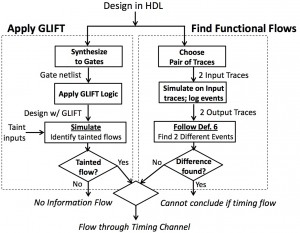 The article “Leveraging Gate Level Properties to Identify Hardware Timing Channels” was accepted to the IEEE Transactions on Computer-aided Design of Integrated Circuits and Systems (TCAD). Jason was the lead author along with co-authors Sarah Meiklejohn (UCSD), Timothy Sherwood (UCSB), and Ryan. This paper formalizes how Gate Level Information Flow Tracking can be used to detect timing channels: a form of information leak where secret information can affect run time.
The article “Leveraging Gate Level Properties to Identify Hardware Timing Channels” was accepted to the IEEE Transactions on Computer-aided Design of Integrated Circuits and Systems (TCAD). Jason was the lead author along with co-authors Sarah Meiklejohn (UCSD), Timothy Sherwood (UCSB), and Ryan. This paper formalizes how Gate Level Information Flow Tracking can be used to detect timing channels: a form of information leak where secret information can affect run time.
Dr. Chris Barngrover Defends His PhD Thesis
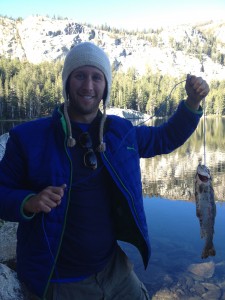 Congratulations to Dr. Barngrover on successfully defending his thesis titled “Automated Detection of Mine-Like Objects in Side Scan Sonar Imagery”. His PhD research focused detecting underwater mines using side scan sonar on autonomous underwater vehicles. He developed a number of computer vision techniques that can accurate detect these mines. Additionally, he developed the first method of using a brain-computer interface system to quickly identify the mines. During his time in the Kastner Group, he also became a skilled fisherman as evidenced by the nice rainbow trout that he caught during one of our group retreats in Mammoth. Dr. Barngrover will continue to work at SPAWAR after graduation.
Congratulations to Dr. Barngrover on successfully defending his thesis titled “Automated Detection of Mine-Like Objects in Side Scan Sonar Imagery”. His PhD research focused detecting underwater mines using side scan sonar on autonomous underwater vehicles. He developed a number of computer vision techniques that can accurate detect these mines. Additionally, he developed the first method of using a brain-computer interface system to quickly identify the mines. During his time in the Kastner Group, he also became a skilled fisherman as evidenced by the nice rainbow trout that he caught during one of our group retreats in Mammoth. Dr. Barngrover will continue to work at SPAWAR after graduation.
Team FANGS Wins Honorable Mention at Cornell Cup
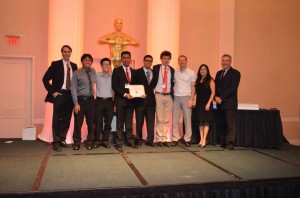 Team FANGS took home an honorable mention at the Cornell Cup. The team consisted of Engineers for Exploration members Xavier Tejeda, Dominique Meyer, Andrew Elgar, Kevin Cheng, and Jorge Pacheco. The team was advised by Ryan. These undergraduate students spent the past several months developing a terrestrial vehicle that is capable of remotely monitoring wolves at the California Wolf Center. They competed with over 30 teams in Orlando, FL on May 2-3.
Team FANGS took home an honorable mention at the Cornell Cup. The team consisted of Engineers for Exploration members Xavier Tejeda, Dominique Meyer, Andrew Elgar, Kevin Cheng, and Jorge Pacheco. The team was advised by Ryan. These undergraduate students spent the past several months developing a terrestrial vehicle that is capable of remotely monitoring wolves at the California Wolf Center. They competed with over 30 teams in Orlando, FL on May 2-3.